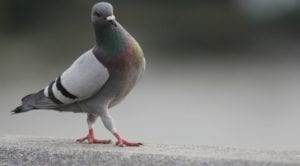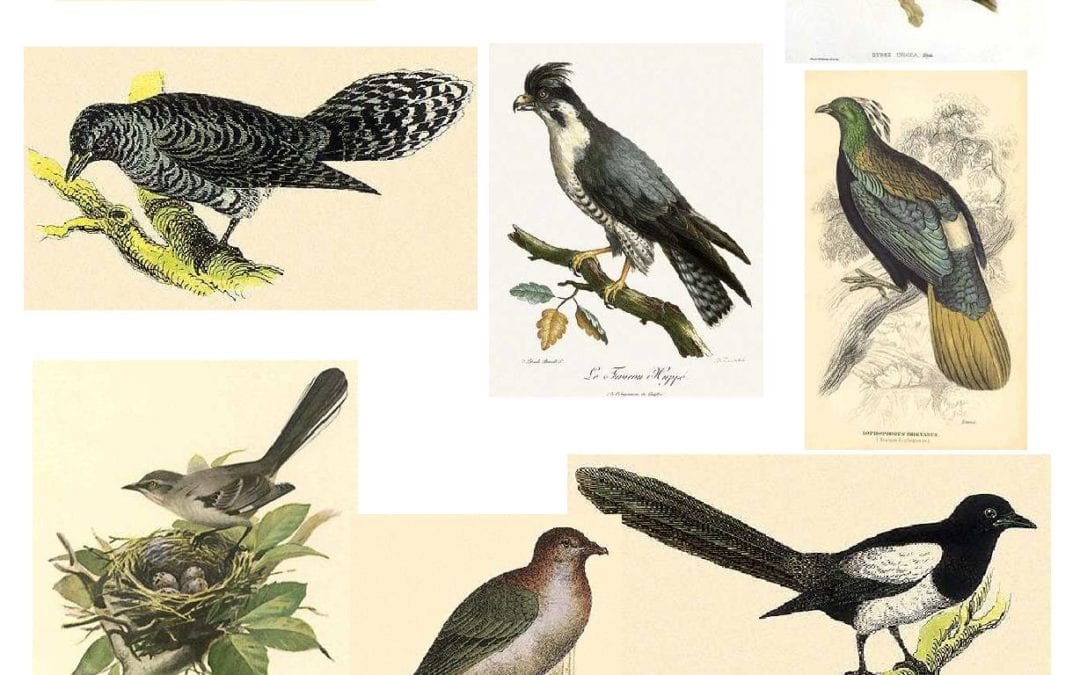
by Pigeon Patrol | Jun 14, 2023 | Bird Spike, Pigeon Predators, Pigeon Spikes, Pigeons, Pigeons in the News, Raccoons, Sparrows, UltraSonic Bird Control
These were the words of Victor Newton as he wrote for the Aberdeen Press and Journal in 1943, describing ‘how pigeons play their part in war.’ And so, in this special blog, we will discover how pigeons were used in both the First World War and Second World War, unearthing stories of their great bravery through the pages of our newspapers.
As Leslie Saxthorpe wrote prior to the outbreak of the Second World War in the Nottingham Journal, ‘it is impossible to quote all the self-sacrificing deeds that stand to the ever-lasting honour of the birds,’ but this blog will go some way to celebrating the homing and carrier pigeons who helped to save lives, whilst putting themselves in extreme danger.
An Old Fashioned Post in Modern War
The outbreak of the First World War saw the tragic collision of antiquated military tactics with the latest advances in technology. As such, it also saw the introduction of modern methods of communication; however, these did not prove to be reliable, as one American correspondent noted in 1916, whilst stationed behind the German lines:
It is impossible to depend on telephonic communications…so often are the wires cut and so dangerous is it to repair them. This has led to the revival of carrier-pigeon communication, not for long distances, but as the only dependable medium of communication from the front to the rear.
Indeed, the British, French and German armies were all using carrier pigeons as a method of communication, as did the American army when they joined the conflict. Pigeons were employed to carry messages between the lines, and in 1915 the Illustrated London News pictures ‘The Pigeon-Express.’ Housed in a converted motor-bus, these pigeons were the ‘winged messengers’ of the French army.
Pigeons were also used by airmen, the Illustrated London News explaining how ‘every seaplane carries two birds, to send duplicate emergency messages…they replace wireless in small vessels, and some sea planes.’
And so it is no surprise that in 1918 the Boston Guardian carried this stern message:
Farmers who are in the habit of shooting pigeons should be careful to confine their attention only to wood-pigeons. They should remember that HM Government to-day employ large numbers of homing pigeons, which are to be met with all over the country. The destruction of these trained birds by thoughtless gunners may entrail serious consequences….Their work is a matter of life and death to our fighting men, and many a man alive to-day owes his life to the speed of the homing pigeon.
Heavy penalties were set to be issued to those who harmed any homing pigeons – for they were the heroes of the sky, and necessitated protection from those ‘thoughtless persons’ intent on a bit of sport.
Moreover, newspapers from the First World War abounded with stories relating to the pigeons who had been instrumental in saving lives – and here are just a selection of them.
Skipper Crisp – A Forlorn Hope
The Illustrated London News in March 1918 pictures the ‘forlorn-hope messenger’ that mortally wounded Skipper T Crisp RNR sent off, in a desperate attempt to seek assistance. His vessel, the ‘‘Nelson’ had been attacked by a U-boat. Dying, Crisp managed to affix a ‘hastily scribbled message’ to a pigeon, which read: ‘Nelson’ being attacked by submarine – Skipper killed – send assistance at once.’
The rest of the crew was saved, as relates the Boston Guardian, ‘but only through the timely arrival of their pigeon messenger.’ As for the heroic Crisp, he was posthumously awarded the Victoria Cross by King George V.
Cher Ami – A Wartime Celebrity
Perhaps the most famous pigeon to emerge from the First World War was Cher Ami. In an article some twenty years later penned by Leslie Saxthorpe for the Nottingham Journal, Saxthorpe relates how English-born Cher Ami ‘by its marvelous courage saved an American battalion from being wiped out.’
The so-called ‘Lost Battalion,’ commanded by Major Charles Whittlesey, was ‘being subjected to fierce artillery fire; and the field telegraph had been cut.’ The only recourse was messenger pigeon. Saxthorpe relates how six pigeons were sent by the Major on this perilous rescue message, ‘one by one, only to see them fall.’
The seventh was Cher Ami, who ‘got away, although hit.’ Shrapnel had broken his breastbone, whilst his right leg had been shot away. But despite these devastating injuries, Cher Ami was able to fly the 25 miles needed to fetch help, and the battalion was saved. Thankfully, he recovered from his wounds and was taken to the United States, where he received a welcome ‘as if he had been General Lafayette come to life again.’
When Cher Ami eventually passed away, ‘full of years and honour,’ his body was placed in Washington’s Smithsonian Institute.
The Mine-Sweepers’ Hope
Less exalted than its feted American cousin, but still as brave, was a bird known as the ‘Mine Sweepers’ Hope.’ The Nottingham Journal tells of how this particular pigeon braved the ‘North Sea under all conditions,’ arriving ‘time after time from over the waters, landing at a spot in Essex, sometimes half-frozen, carrying messages.’ One of these message was news of a Zeppelin attack on mine-sweepers, the first of its kind, and ‘the news enabled planes to be sent and the airships were driven off.’
Another pigeon was responsible for saving lives at sea, after a ‘flying boat and hyrdoplane got into difficulties in stormy weather.’ With all lives on board threatened, the Boston Guardian tells of how a pigeon was released with a message requesting help. ‘In the teeth of a fierce wind the gallant bird fought its way home, only to die from exhaustion on its arrival.’ But the message was safely delivered; ‘assistance was sent with all speed, and the lives of both crews were saved.’
Meanwhile, former cricketer Harold Gilligan got into difficulties whilst flying over the German Fleet, his aircraft having been struck by a piece of shrapnel. The aircraft made a crash landing in the sea, and four pigeons were sent to cover the enormous distance home – some 400 miles. The Nottigham Journal reports how ‘only one of the birds got through,’ the distance being so great, and the weather condition being so awful. Finally, the exhausted pigeon landed on the coast of Norfolk, and was found by the coastguard. The airmen were eventually rescued after three days.
With over 100,000 birds attached to both the Allied and the German forces, these stories represent a fraction of the bravery shown by the feathered battalions during the First World War. And with the advent of the Second World War, would their services again be required?
More Homing Pigeons Than Ever
The answer to this was a clear yes; pigeons were in more demand than ever. The Aberdeen Press and Journal in 1943 relates how ‘despite modern scientific instruments the homing pigeon still finds employment. There are now more homing pigeons than there ever were.’
Used by the RAF on their ‘bombing raids,’ pigeons accompanied an aircraft in case it was shot down, bringing ‘word of the exact location of the crew.’ Meanwhile, in North Africa, pigeons were being used with great effect in desert warfare.
The Illustrated London News reports how the Royal Corps of Signals ‘is using carrier-pigeons in the Western Desert as a valuable alternative method of communication when telephone wires are cut and it is impossible to use wireless,’ just like the armies of the First World War. Touchingly, the pigeon handlers were picked from men ‘who were pigeon fanciers in civil life.’
The Illustrated London News reports on the success of the endeavor, and pictures two particular pigeons, Crusader and The Blue, ‘who carried the first battle pictures in the Western desert.’
The Dickin Medal – ‘We Also Serve’
The Dickin Medal was established by PDSA founder Maria Dickin in 1943 to honour the work of animals in the Second World War, and it is little wonder that pigeons have received the most Dickin Awards, totaling 32 between 1943 and 1949 – dogs having received 18.
Here we celebrate a handful of these feathered winners from the Second World War.
Take Winkie, who received the Dickin Medal for saving an air crew. According to the Illustrated London News, after her plane crashed, she ‘fell into the oil-covered sea.’ Freeing herself, she flew the 120 miles back to base, and ‘the search for the crew was then successfully redirected.’
There was also a royal winner of the award, King George VI’s own racing pigeon Royal Blue. As reported in the Liverpool Echo in 1945, Royal Blue had been ‘sent on war service in 1940,’ and had since displayed ‘outstanding achievement.’
Commando, and seven other pigeons, were on display at the ‘To Victory with the RAF‘ exhibition in London. Commando was particularly notable, for he ‘made ninety operational trips over enemy territory,’ and had been presented with the Dickin Medal for his valiant efforts.
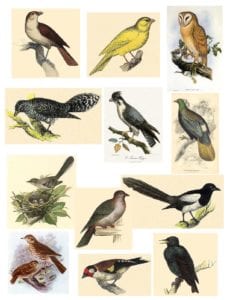
Meanwhile in June 1945, the Newcastle Evening Chronicle reports on the exploits of two more brave pigeons, who also received the Dickin Medal. William of Orange was honoured for his role in the ‘airborne operations at Arnhem,’ whilst his contemporary Ruhr Express was dropped ‘by parachute within enemy lines 300 miles from base and brought back valuable information in record time.’
Tommy, a carrier-pigeon, had a slightly circuitous route to his award. Injured, he had strayed to the Netherlands in 1942, where Mr D Dryver nursed him back to health. When Tommy had recovered, Mr Dryver sent him ‘back to England with valuable information.’ The Illustrated London News reports how Tommy received the Dickin Medal for his services, whilst his Dutch saviour was given ‘two RAF pigeons in token of his good services, and his courage and presence of mind.’
Rounding of our roster of brave pigeons are the two ‘D-Day Pigeons.’ The Daily Mirror in January 1947 reports how they were awarded the Dickin Medal ‘for flying from France with early news of the invasion.’ One of the brave pigeons died soon afterwards, ‘on another operational flight.’
There are of course many other pigeons who made the ultimate sacrifice; these mentioned here represent a fraction of those who displayed bravery in testing conditions.
Source
Pigeon Patrol Products & Services is the leading manufacturer and distributor or bird deterrent (control) products in Canada. Pigeon Patrol products have solved pest bird problems in industrial, commercial, and residential settings since 2000, by using safe and humane bird
deterrents with only bird and animal friendly solutions. At Pigeon Patrol, we manufacture and offer a variety of bird deterrents, ranging from Ultra-flex Bird Spikes with UV protection, Bird Netting, 4-S Bird Gel and the best Ultrasonic and audible sound devices on the market today.
Voted Best Canadian wholesaler for Bird Deterrent products ten years in a row.
Contact us at 1 877-4-NO-BIRD,(604) 585-9279 or visit our website at www.pigeonpatrol.ca
Pigeon/Pigeon Patrol / Pigeons Roosing / Vancouver Pigeon Control / Bird Spikes / Bird Control / Bird Deterrent / PIgeon Deterrent / Surrey Pigeon Control / Pest / Seagull deterrent / Vancouver Pigeon Blog / Birds Inside Home / Pigeons in the cities / Ice Pigeons / What to do about pigeons / sparrows, Damage by Sparrows, How to Keep Raccoons Away, Why Are Raccoons Considered Pests / De-fence / Pigeon Nesting / Bird Droppings / Pigeon Dropping / woodpecker control / Professional Bird Control Company / Keep The Birds Away / Birds/rats/seagull/pigeon/woodpecker/dove/sparrow/pidgeon control/pidgeon problem/pidgeon control/flying rats/pigeon problems/ bird netting/bird gel/bird spray/bird nails/bird guard
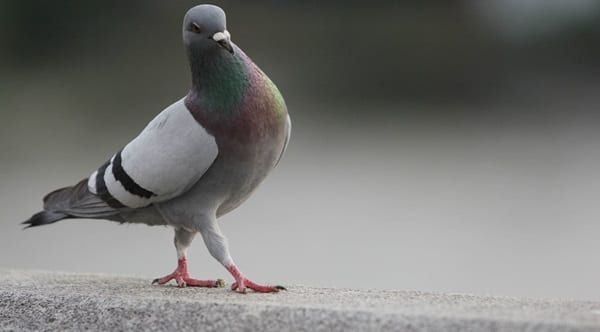
by Pigeon Patrol | May 30, 2023 | Bird Spike, Pigeon Predators, Pigeon Spikes, Pigeons, Pigeons in the News, Raccoons, Sparrows, UltraSonic Bird Control
The simple truth is the danger varies depending on the specific infestation. However, if you have a pigeon infestation of any size on your home or property, there is a real risk of contracting an illness from their droppings. The safe bet is to deal with your pigeon infestation as soon as possible to remove any risk of illness.
Pigeons can contract and carry many diseases and parasites which do end up in their droppings. When pigeons find a place on your roof or property to call home, they will quickly create a large mess of their own poop.
Typically at least one of two things are going to eventually happen with pigeons living on your property:
1. Pigeons will poop on your roof and mother nature will make sure that waste ends up on the ground, or in your bushes, trees, and plants. This has the danger of possibly getting tracked into your home by you, your family and even pets. This will cause any disease or even parasites in those droppings to end up right in your home.
2. The pigeons will find a comfortable place to nest and usually will just poop in one place. Those droppings will pile up on your roof or a ledge and will cause direct property damage. Droppings are very acidic and can destroy roofing materials and even damage solar panels. If you get a roof leak, rainwater can soak the droppings causing even more property damage. That tainted water will bring everything in their droppings right into your attic and anywhere the leak travels.
Disease or not, I think can we agree that having a bunch of bird poop on your property is just plain gross!
Speaking of diseases and parasites caused by pigeons, here’s the most common ones you should be concerned with…
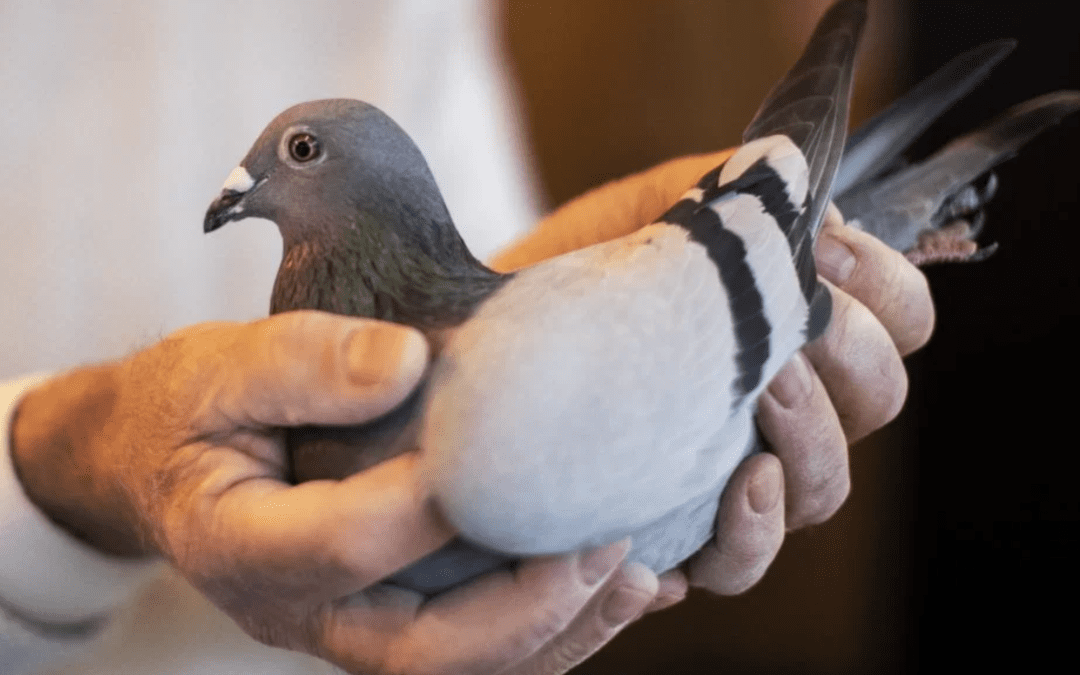
by Pigeon Patrol | May 23, 2023 | Bird Spike, Pigeon Predators, Pigeon Spikes, Pigeons, Pigeons in the News, Raccoons, Sparrows, UltraSonic Bird Control
Animals can be entertaining and educational. But children, especially children under 5 years of age, are more likely to get sick from germs animals can sometimes carry. Children can learn a lot from animals, and it’s important to make sure they stay safe and healthy while they’re learning. If you plan to have an animal in your classroom, whether it’s a class pet or for a hands-on learning experience, be aware of the risks and how to prevent illness. You can help kids enjoy and learn from animals while staying healthy.
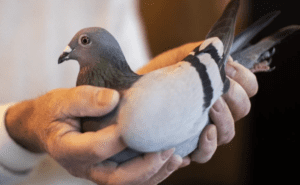
Animals can sometimes spread germs
Animals can sometimes carry germs that can make people sick, even if they look clean and healthy. You don’t have to touch an animal to get sick – the germs can spread to cages, bedding, and wherever animals roam.
There have been disease outbreaks from hatching eggs and chicks in the classroom and from contaminated animal products used for hands-on learning, such as owl pellets for dissection. Salmonella and E. coli are common germs spread by animals.
How to prevent germs from spreading in the classroom
- Do not bring reptiles, amphibians, poultry, rodents, or ferrets into schools, daycare centers, or other settings with children under 5 years of age.
- Adults should always supervise children’s contact with animals. Never allow children to put their hands or objects (including pacifiers) in their mouth while around animals.
- Create specific areas for interaction with animals. Do not allow animals to roam freely around the classroom, especially in areas where food or drink is prepared, served, or eaten.
- Do not dissect animals or other animal products where food for people is prepared, served, or eaten. Thoroughly clean and disinfect surfaces used for dissection.
- Consult with parents to determine special considerations for children who have allergies, asthma, or other illnesses.
- Students should wash their hands with water and soap right after handling animals, their food, or their habitats (for example, cages, terrariums, aquariums, water bowls, and toys).
- When around animals, also wash hands after removing dirty clothes or shoes, before eating and drinking, and before preparing food or drinks.
- Adults, including teachers, should always supervise handwashing for young children.
- Use hand sanitizer if running water and soap are not available. If you only use hand sanitizer, be sure to wash your hands with soap and water as soon as possible.
- Clean and disinfect all areas where animals have been.
- Do not clean tanks, feeders, water containers, and other equipment in sinks or areas where food is prepared, served, or eaten.
Check that animals are healthy before bringing them into school
- Animals can look clean and healthy and still spread germs. Make sure all animals have appropriate and regular veterinary care, and proof of rabies vaccination for dogs and cats, according to local or state requirements.
- If the animal comes from a different state or country, it may need a health certificateexternal icon issued by a veterinarian to travel across state lines or to enter the United States.
- Check local regulations, as well as school policies, before bringing animals into schools.
- If the animal becomes sick or dies:
- Contact your veterinarian.
- Take extra precaution when handling a sick animal because a sick or stressed animal is more likely be shedding harmful germs that can make people sick or to bite which can cause injury or spread germs.
- Inform the pet store or breeder about the animal’s illness or death as soon as possible. Consider waiting before purchasing another pet from the same source.
- Clean and disinfect the cage before reusing with another animal.
- If the animal bites someone:
- Wash wounds with warm soapy water immediately.
- Seek medical attention if:
- The animal appears sick.
- You don’t know if the animal has been vaccinated against rabies.
- The wound is serious.
- The wound becomes red, painful, warm or swollen.
- It has been more than 5 years since your last tetanus shot.
Source
Pigeon Patrol Products & Services is the leading manufacturer and distributor or bird deterrent (control) products in Canada. Pigeon Patrol products have solved pest bird problems in industrial, commercial, and residential settings since 2000, by using safe and humane bird
deterrents with only bird and animal friendly solutions. At Pigeon Patrol, we manufacture and offer a variety of bird deterrents, ranging from Ultra-flex Bird Spikes with UV protection, Bird Netting, 4-S Bird Gel and the best Ultrasonic and audible sound devices on the market today.
Voted Best Canadian wholesaler for Bird Deterrent products ten years in a row.
Contact us at 1 877-4-NO-BIRD,(604) 585-9279 or visit our website at www.pigeonpatrol.ca
Pigeon/Pigeon Patrol / Pigeons Roosing / Vancouver Pigeon Control / Bird Spikes / Bird Control / Bird Deterrent / PIgeon Deterrent / Surrey Pigeon Control / Pest / Seagull deterrent / Vancouver Pigeon Blog / Birds Inside Home / Pigeons in the cities / Ice Pigeons / What to do about pigeons / sparrows, Damage by Sparrows, How to Keep Raccoons Away, Why Are Raccoons Considered Pests / De-fence / Pigeon Nesting / Bird Droppings / Pigeon Dropping / woodpecker control / Professional Bird Control Company / Keep The Birds Away / Birds/rats/seagull/pigeon/woodpecker/dove/sparrow/pidgeon control/pidgeon problem/pidgeon control/flying rats/pigeon problems/ bird netting/bird gel/bird spray/bird nails/bird guard
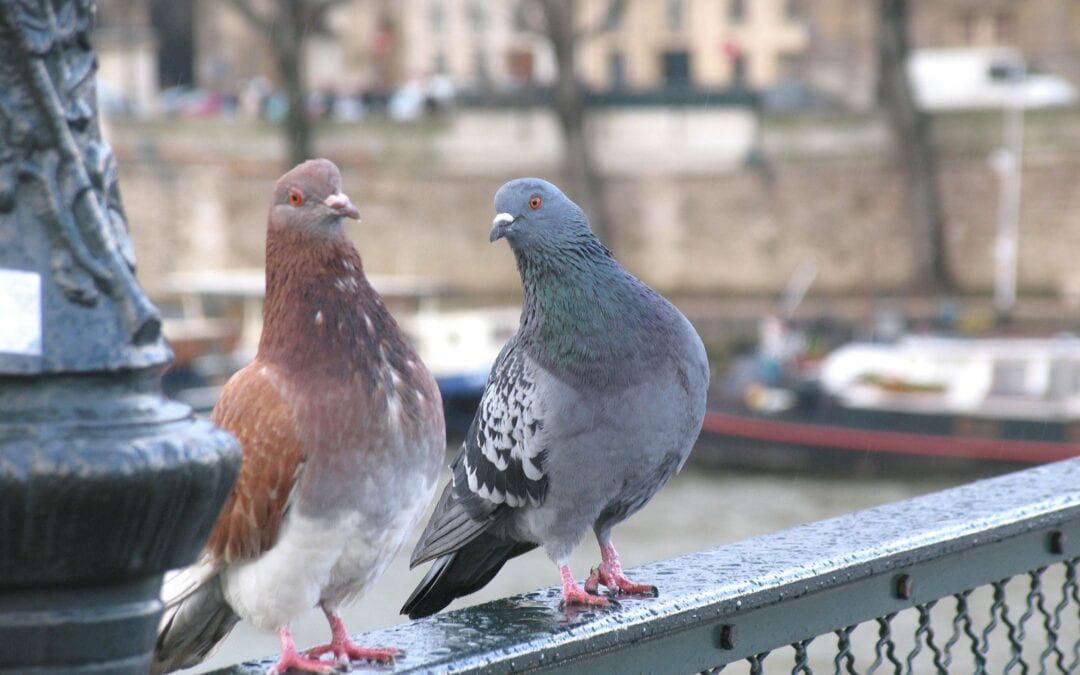
by Pigeon Patrol | May 23, 2023 | Bird Spike, Pigeon Predators, Pigeon Spikes, Pigeons, Pigeons in the News, Raccoons, Sparrows, UltraSonic Bird Control
If you are a pet bird lover or taking your baby to a house with bird pets and wondering if it’s healthy or unsafe for your child, then here is what you must know about the safety of the babies when they are around birds.
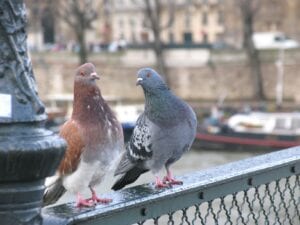
The Basics about the Problem with Birds and Babies
The birds like gulls and pigeons are categorized as pests as they spread diseases through the dust and their feathers. Pregnant women and babies are prohibited to come in contact with the birds like pigeons, gulls and parrots as they can cause sickness. Also, the transmission of some diseases from a few birds occurs through direct contact, inhaling, food contamination and some other ways.
Is Bird Dropping Toxic to Babies?
Well the below-mentioned diseases will explain everything.
Some of the Common Birds Related Diseases
Psittacosis (Parrot Fever)
Parrot fever, parrot infection or Psittacosis which is a disease related to newborn baby and parrot occurs due to bacteria called Chlamydia Psittaci. The name may point towards parrots but there are other birds too that spread parrot fever including pigeon, duck and chicken. The primary symptoms of this disease resemble that of flu. Victims may experience fever, dry and non-productive cough. Nausea, vomiting, muscle pain, diarrhea, tiredness and fatigue are some other symptoms that indicate that a person is suffering from parrot fever.
Parrot disease mainly spreads to human and people with poor immunity, elderly people, babies and pregnant women are highly prone to this disease. Also, people with respiratory issues easily get sick due to Parrot disease. Dust, feathers and cried bird droppings are the main factors that encourage the spreading of this disease.
So, if you are sick and you got birds at home then immediately consult with your doctor or health practitioner and mention that you have parrot or other pet birds at home. Doctors usually prescribe antibiotics for the treatment of parrot disease but it’s important to take precautions when you have kids at home as their immunity is comparatively weaker than the adults and they are highly prone to this disease. Make sure your baby washes his/her hands after touching the bird, the cage or the feather/droppings.
Allergic Alveolitis
Allergic Alveolitis which is commonly known as Hypersensitivity Pneumonitis is basically a lung infection where the lung is inflamed. This occurs due to the exposure to bird droppings, dust and feathers. This can also occur in the outer part of the body. Repeated exposure to these bird residues that contain fungi and bacteria causes a reaction in the body’s defence system making you sick.
Ref: https://www.sciencedirect.com/science/article/pii/B9781455733835000646
Salmonella
Salmonella infections that are commonly known as Salmonellosis spread through the feces and feathers of the birds. This infection mainly affects the intestinal tract. The symptoms of this diarrheal sickness include diarrhea, chills, fever, vomiting and abdominal cramps.
Ref: https://meridianbirdremoval.com/why-birds-cause-salmonellosis-risk/
Mycobacterium Avian Complex (MAC):
MAC usually affects people with a poor immune system. This disease is mainly caused by the organisms called M Intracellulare and M Avium. The results of this disease can be fatal sometimes.
Diseases caused by pigeons
If you see pigeons around your home and you got kids then you need to be a bit concerned about them. The common troubles faced due to pigeons are their droppings, feathers and dust spreading in the balcony. Pigeon droppings contain fungus and it affects the lungs. Make sure your laundry, especially kid’s laundry is safe is not exposed to the dust and droppings caused by the pigeons. People who have pet birds or simply pests around them generally ask a question – can my bird make pregnant women sick? Yes, they can. Prevent your baby and pregnant woman, if there is any, from getting in contact with the debris, feathers and droppings caused by the pigeons. Educate them about these birds and the health issues caused due to them.
Bird Dropping: Toxic for Humans
Bird droppings are very dangerous to human health. Here are some major hazards due to bird droppings:
E.Coli
This infection occurs due to the enteric bacteria. It is usually found in bird feces.
Candidiasis
This fungal infection is usually caused due to pigeon droppings and affects many organs like intestine, skin, mouth, respiratory system and urogenital tract.
St. Louis Encephalitis
It is a neurological disorder which may end up taking the form of paralysis.
Histoplasmosis
This lethal disease is caused due to the fungus present in bird droppings.
Salmonellosis
This disease is usually experienced when the dust and bacteria come in contact with the food through ventilation or air condition and leads to food poisoning.
The beautiful colors, enchanting sounds and humorous behaviours of birds are always adorable. There is no dearth of pet lovers and kids always fall into this vast category.
BUT, the immune system of the kids are weak and they are very vulnerable to dust and bacteria. If birds are around, dust and droppings will be a common sight but you can take measures to prevent your kids from getting exposed to these things to avoid serious illnesses.
Source
Pigeon Patrol Products & Services is the leading manufacturer and distributor or bird deterrent (control) products in Canada. Pigeon Patrol products have solved pest bird problems in industrial, commercial, and residential settings since 2000, by using safe and humane bird
deterrents with only bird and animal friendly solutions. At Pigeon Patrol, we manufacture and offer a variety of bird deterrents, ranging from Ultra-flex Bird Spikes with UV protection, Bird Netting, 4-S Bird Gel and the best Ultrasonic and audible sound devices on the market today.
Voted Best Canadian wholesaler for Bird Deterrent products ten years in a row.
Contact us at 1 877-4-NO-BIRD,(604) 585-9279 or visit our website at www.pigeonpatrol.ca
Pigeon/Pigeon Patrol / Pigeons Roosing / Vancouver Pigeon Control / Bird Spikes / Bird Control / Bird Deterrent / PIgeon Deterrent / Surrey Pigeon Control / Pest / Seagull deterrent / Vancouver Pigeon Blog / Birds Inside Home / Pigeons in the cities / Ice Pigeons / What to do about pigeons / sparrows, Damage by Sparrows, How to Keep Raccoons Away, Why Are Raccoons Considered Pests / De-fence / Pigeon Nesting / Bird Droppings / Pigeon Dropping / woodpecker control / Professional Bird Control Company / Keep The Birds Away / Birds/rats/seagull/pigeon/woodpecker/dove/sparrow/pidgeon control/pidgeon problem/pidgeon control/flying rats/pigeon problems/ bird netting/bird gel/bird spray/bird nails/bird guard
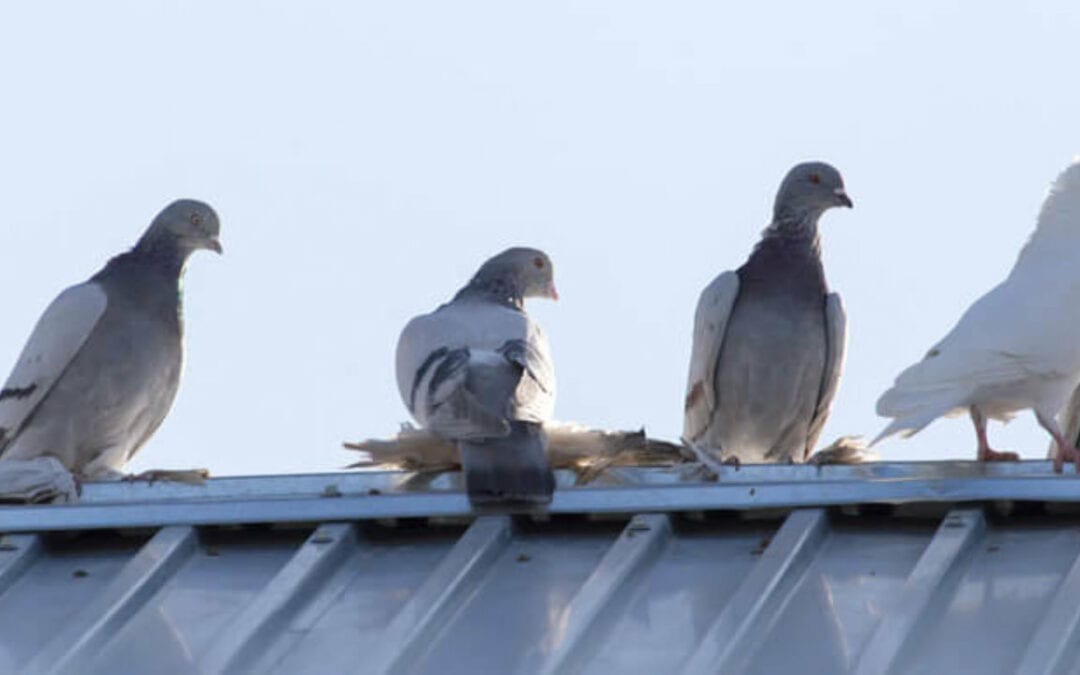
by Pigeon Patrol | May 23, 2023 | Bird Spike, Pigeon Spikes, Pigeons, Pigeons in the News, Raccoons, Sparrows, UltraSonic Bird Control
A proliferation of pigeons and their toxic poo is to blame for the current closure of the riverside walkway which runs alongside the RSC.
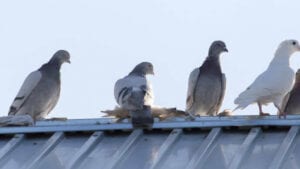
Pigeon faeces is acidic, eroding both metal and stonework, and also contains pathogens that are hazardous to humans. The inhaling of irritant airborne dust particles can cause illnesses such as ornithosis – a flu-like infection, lung inflammation, and asthma.
A theatre spokesperson explained that essential clean-up work was being done to the balconies of the dressing rooms following a “recent spate of pigeons”.
They said: “With the building being quiet over the past year – pigeons have settled and reproduced quickly producing waste which needs to be cleaned up in line with health and safety measures.”
The RSC is also taking steps to deter the pigeons from dwelling on the balconies. They explained: “We will install black netting, wires and unintrusive spikes around these areas to stop pigeons from continuing to foul the area. These are preventive measures only and will not harm any pigeons and we are working with GCB Falconry and Pest Solutions LTD to do this work.”
The walkway is expected to open today (Friday).
Source
Pigeon Patrol Products & Services is the leading manufacturer and distributor or bird deterrent (control) products in Canada. Pigeon Patrol products have solved pest bird problems in industrial, commercial, and residential settings since 2000, by using safe and humane bird
deterrents with only bird and animal friendly solutions. At Pigeon Patrol, we manufacture and offer a variety of bird deterrents, ranging from Ultra-flex Bird Spikes with UV protection, Bird Netting, 4-S Bird Gel and the best Ultrasonic and audible sound devices on the market today.
Voted Best Canadian wholesaler for Bird Deterrent products ten years in a row.
Contact us at 1 877-4-NO-BIRD,(604) 585-9279 or visit our website at www.pigeonpatrol.ca
Pigeon/Pigeon Patrol / Pigeons Roosing / Vancouver Pigeon Control / Bird Spikes / Bird Control / Bird Deterrent / PIgeon Deterrent / Surrey Pigeon Control / Pest / Seagull deterrent / Vancouver Pigeon Blog / Birds Inside Home / Pigeons in the cities / Ice Pigeons / What to do about pigeons / sparrows, Damage by Sparrows, How to Keep Raccoons Away, Why Are Raccoons Considered Pests / De-fence / Pigeon Nesting / Bird Droppings / Pigeon Dropping / woodpecker control / Professional Bird Control Company / Keep The Birds Away / Birds/rats/seagull/pigeon/woodpecker/dove/sparrow/pidgeon control/pidgeon problem/pidgeon control/flying rats/pigeon problems/ bird netting/bird gel/bird spray/bird nails/bird guard

by Pigeon Patrol | May 18, 2023 | Bird Spike, Pigeon Predators, Pigeon Spikes, Pigeons, Pigeons in the News, Raccoons, Sparrows, UltraSonic Bird Control
NICK OUD knows when to put his faith in a bird. As he clasps a homing pigeon between his hands, he looks for three things: curiosity, toughness, and stubbornness. A bird with these qualities is likely to go the distance. His benchmark is a remarkable hen named Lady Hearst, who won a mammoth 800-kilometre race in 2015.

Bird droppings on building window
The odyssey started in Hearst, Ontario, a town of about 5,000 people off the Trans-Canada Highway between Thunder Bay and Timmins. It began, as all pigeon races do, with a trailer resembling a wall of PO boxes. In it were 426 birds, ready to race the hundreds of kilometres back to their homes. For Lady Hearst, that challenge boiled down to an eleven-hour trailer ride northwest to a place she had never been before with seemingly no opportunity to get her bearings. Once released, she had to contend with the uniform terrain of rocks and trees that makes up part of the Canadian Shield.
Pigeon racing can be a brutal sport. Beyond the sheer length of the races, incidents of doping, mass deaths, and illegal gambling have detracted from what should be an exhibition of an animal’s incredible skill. While the Canadian racing scene is lower profile than its cutthroat counterparts in the UK, South Africa, and the United States, the challenge for the birds remains the same.
Nonetheless, Oud’s hen made the journey look like a cinch. She took flight from Hearst and made a beeline south to her home, just outside of Delhi, Ontario. After fourteen hours on the wing, she flew straight through the one-way door on the outside of Oud’s loft, finishing in first place. From that point on, she was Oud’s star hen.
Oud has had no shortage of practice selecting the perfect racing bird. One of his first memories after emigrating from the Netherlands to the township of Wainfleet, Ontario, was of nabbing a pigeon off of his roof and building it a loft out of the wooden crate that had carried his belongings to Canada. “We didn’t know any better,” Oud says. “We just grabbed the pigeon [and then realized] now we don’t have a loft for it.” Over time, he noticed that the pigeon would return to its crate-turned-loft no matter how far it strayed. That revelation changed his life.
While Oud, now seventy-five, knows when a bird is strong enough to make such a journey, he couldn’t say why she does it—or how. From around 2000 BCE, when it’s thought that ancient Sumerians discovered pigeons’ amazing homing abilities, to now, we still don’t quite know how these birds orient themselves in the sky. Scientists have various theories, but they have yet to fully understand the phenomenon. “It’s a mystery,” Oud says. “It’s part of what makes the sport so interesting.”
While Oud is content to live with that mystery, the stakes are much higher for bird researchers. Comprehending how these animals find their way home could help us understand more about the animal kingdom. “Animals are very similar, at least across vertebrates,” says Elizabeth Gow, a migration scientist formerly with Birds Canada. “If you find something out about one group of animals, it could be the same across other animals.”
FOR CHARLES WALCOTT, cracking the mystery of avian navigation has been a goal since the 1960s. Now a professor emeritus at Cornell University’s department of neurobiology and behaviour, Walcott has been fascinated by homing pigeons ever since a graduate student approached him with a problem. The pupil had developed an attachable radio transmitter to track the movements of birds, but the seagulls he had been attempting to use weren’t cooperating. They would take off with the contraption, fly to the city dump, and stay there. Walcott suggested he use homing pigeons instead of seagulls so that the student wouldn’t keep losing transmitters. So intrigued was Walcott by the student’s research project that he then took an extraordinary step. To track the pigeons while they flew in real time, Walcott learned to fly a Cessna 180.
“I have several thousand hours of flight time, all in circles following homing pigeons on their way home,” he says. “Apparently [the pattern] is quite distinct on radar, so the air traffic people would know what we were up to and give us a hard time.”
For scientists, there is no shortage of migration puzzles to be solved. “Monarch butterflies manage to fly all the way down [from Canada] to Mexico to spend the winter,” says Walcott. “Then, the next spring, they come up and they go to Texas and have a brood, and then they go farther north and have another brood. By the time they get to Canada, they’re probably three generations away from the ones that overwintered in Mexico. Suddenly, generation four turns around, and they’re able to fly back to that one little spot in Mexico.” Whales and caribou are two other species with lengthy migrations made possible by faculties still unknown to humans. “It’s a general problem to which we really don’t have a very good answer.”
Walcott’s work involves isolating the different “compasses” that pigeons and other species use to navigate. Three key types, he explains, are the earth’s magnetic field, the sun, and the stars. These seem to generally occur throughout the animal kingdom, he explains, though pigeons do not rely on stars because they sleep at night. But then there are other mechanisms. Walcott says that salmon somehow know to return to the streams where they first hatched. Scientists have confirmed that the fish can sniff their way around their birth stream once they get there, but as Walcott says, “Do you suppose you can really smell the Columbia River out in the middle of the Pacific Ocean? Yeah, I doubt it. I think there’s something else going on.”
While most migratory birds use a variety of compasses, the feats of pigeons differ from, say, the biannual migration of the yellow warbler. For one, migratory birds use flight paths to travel north and south. Each year that they make the trip, they take a similar route. Racing pigeons like Lady Hearst don’t have that luxury. They’re transported to a completely foreign environment and still somehow find their way back home.
Even with many a day spent over Ithaca, New York, monitoring the travels of homing pigeons, Walcott is stumped. “If you take a pigeon someplace where it’s never been before, the first thing it has to do is figure out what direction is home, and [how they do] that is still mysterious,” Walcott says. Italian scientists say it’s olfaction, but many German scientists believe it’s the earth’s magnetic field. “And then there’s a fellow in California, Jonathan Hagstrum, who says it’s low-frequency sound,” Walcott adds. “My suspicion is that maybe it’s all of the above.”
Gow, the bird-migration scientist, says that all of these theories hold water. “Birds can hear much differently than we can: they hear much higher frequencies and much lower frequencies,” she says. “The sounds emitted by the earth have very low frequencies, so the theory is that pigeons are able to detect those low-frequency sounds.”
A long-held view was that birds were aided in their orientation by a cluster of iron neurons in their beaks, which interacted with the earth’s magnetic field. “But, in the past ten years, people have begun to ask if maybe it’s something else.” Gow posits that this something could well be olfaction. “If you have a colony of birds,” she says, “they can find their individual nest among thousands by smell.”
We may consider them flying rats, but pigeons are smarter than many think. “A lot of these birds have developed a very large hippocampus, which is the part of the brain associated with memory and learning,” Gow says. Although racing birds are bred to enhance their homing capabilities, Gow believes that even common street pigeons can find their way home. “If you were to take a pigeon off the streets of Toronto and take it 500 kilometres away, it could probably find its way back.”
AS THE SUN breaks over the horizon, casting its rays on the fields and forests of rural southern Ontario, Oud unloads four wooden cages packed with pigeons from the back of his silver hatchback. He has selected birds he believes have strong homing qualities and driven them two kilometres from home for their first test flight. He extends their range farther and farther until he feels that they’re adequately prepared to race. “I can tell when they’re ready,” Oud says. “All of a sudden, one day I let ’em out of the basket, and instead of spending time circling and trying to figure out which way, boom, they’re gone.”
As for Lady Hearst, she moved to the breeding loft after her win in 2015. Since then, Oud estimates that she has bred two or three more race winners. She doesn’t lay anymore, but Oud makes sure she remains comfortable.
When Oud walked out of his front door in Wainfleet in the early ’60s, he let his pigeon out knowing it would return but not knowing why. At a time when we think we have it all figured out, it can be humbling to be so vexed by a quandary surrounding a bird that has been tamed, used, and studied by humans for at least 3,000 years. Reflecting back on six decades in the sport and why that first resident of his makeshift loft always returned home, Oud takes a less scientific approach. “It was just understood.”
Source
Pigeon Patrol Products & Services is the leading manufacturer and distributor or bird deterrent (control) products in Canada. Pigeon Patrol products have solved pest bird problems in industrial, commercial, and residential settings since 2000, by using safe and humane bird
deterrents with only bird and animal friendly solutions. At Pigeon Patrol, we manufacture and offer a variety of bird deterrents, ranging from Ultra-flex Bird Spikes with UV protection, Bird Netting, 4-S Bird Gel and the best Ultrasonic and audible sound devices on the market today.
Voted Best Canadian wholesaler for Bird Deterrent products ten years in a row.
Contact us at 1 877-4-NO-BIRD,(604) 585-9279 or visit our website at www.pigeonpatrol.ca
Pigeon/Pigeon Patrol / Pigeons Roosing / Vancouver Pigeon Control / Bird Spikes / Bird Control / Bird Deterrent / PIgeon Deterrent / Surrey Pigeon Control / Pest / Seagull deterrent / Vancouver Pigeon Blog / Birds Inside Home / Pigeons in the cities / Ice Pigeons / What to do about pigeons / sparrows, Damage by Sparrows, How to Keep Raccoons Away, Why Are Raccoons Considered Pests / De-fence / Pigeon Nesting / Bird Droppings / Pigeon Dropping / woodpecker control / Professional Bird Control Company / Keep The Birds Away / Birds/rats/seagull/pigeon/woodpecker/dove/sparrow/pidgeon control/pidgeon problem/pidgeon control/flying rats/pigeon problems/ bird netting/bird gel/bird spray/bird nails/bird guard




